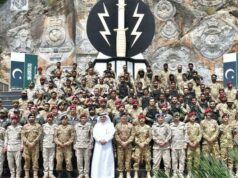Hindu Marriages in Trinidad
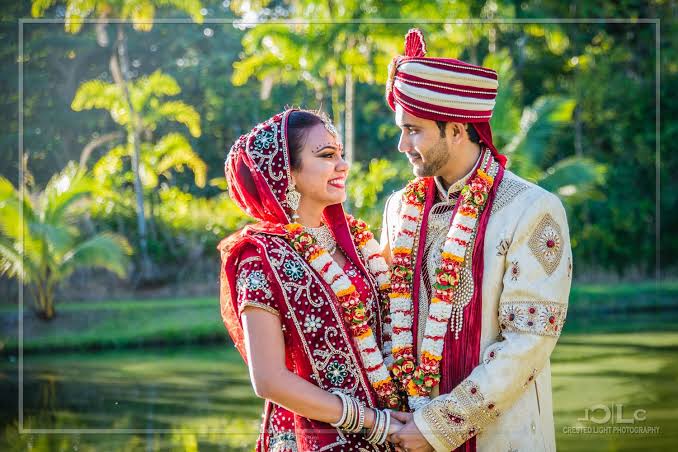
Hinduism entered Trinidad along with the Girmityas, as the indentured labour from India were called. They were contractual labour but like most things British were bonded labour separated by just a thin margin from the African slaves, bought from the Slave Traders.
However the Girmityas as opposed to the captured African Slaves were allowed to carry on-board the ships their possessions and were not separated from their accompanying families. Even then the Indians faced many obstacles in practising their culture upon arrival in Trinidad. The gritty Indians, mostly from the Bhojpur—Mithila—Awadh belt, were able to overcome all challenges to a large extent. As such, Hinduism and the Purabiya customs of the immigrants was transplanted and has survived with a great level of authenticity to this day. Inevitably there are some aspects that got modified which can be deemed a product of the difficulties the religion endured, the geography, the climate, economic conditions, contact with the motherland and the local influence throughout its history in Trinidad.
The Indians proved to be the most effective immigrant group which came to Trinidad till 1917
The Hindu wedding ceremonies, certainly retain numerous similarities with Indian culture. Most of the rituals and customs have been maintained as well as the procedures.
In Trinidad the actual wedding is spread over three days with weeks of pre wedding preparations and post wedding rituals following the days after the wedding. Even the ritual items as well as the rituals themselves to a large part are quite like India. The marriage ceremony has the building of a marwah, hardi night,Matkor, saptipadi, sindoor daan as well as vegetarian meals to name a few.
Though modifications can been seen in the names of the ceremonies and materials used for certain ceremonies. In Trinidad, for Matkor a yellow cloth is used to cover the tray for the procession instead of a red cloth. Similarly, the hardi ( as haldi is called in Bhojpuri ) paste is rubbed onto the bride and groom by little children usually below ten years of age unlike in India where only married women are allowed to apply the hardi. Also in Trinidad the sweets and food prepared will naturally be different than those in India.
As per Pundit Bissessar, the Hindu wedding ceremony has been modified as a result of the degradation of information as well as the misunderstanding of the meanings of rituals which resulted in some being left out.
Pre – wedding rites
Engagement : known as Chay – Kai
This is a simple ceremony that includes the girl’s father, the pundit and family members who visit the boy’s home and gifts are given to the groom to be.
Date of the wedding
This is set by the pundit according to Lagan (auspicious days) and consultations with the boy and girl’s parents. According to tradition, marriage should be celebrated when “the moon is increasing and during the northern course of the sun.” However, the month of Chaitra as well as others should be avoided.
Shraadha for ancestors
This is where gifts and food are offered to the ancestors as a form of “showing respect to the forefathers by faithfully offering something to them and also praying for the happiness of the parties to the marriage.”
Erection of the Marwah
This cannot begin on the third, sixth or ninth day of the month and ‘bad’ periods has to be avoided.
Maticoor or Matokhor Night (Friday Night)
This night is “more traditional than religious” and begins with tassa. The women who have been invited to participate in the night’s celebrations, move from the ‘wedding house’ in search of a “river, stand pipe or Hindu neighbour’s yard pipe. There married women perform a ritual asking the running water to wash away any evil that may be surrounding the bride.” As the women proceed towards the water, the sister or a young girl accompanies the bride with a tray of Indian sweets on her head to be used in the ritual. There is also tassa, singing and dancing.
Following this ritual, the bride returns home and prepares for the ‘Hardi ceremony.’ During the Hardi ceremony, a cloth known as the Kangan wraps a “pen knife, corn and coins and is tied onto the bride.” This is said to protect her and ward off evil. The Hardi ceremony also contains the application of saffaron to the bride, that is, the saffaron root is grated and mixed with coconut oil and rubbed unto the bride by young girls. This application of saffaron is done to cleanse the bride of impurities and make her skin glow for the ceremony as she is not allowed to shower until her wedding day (Sunday). Furthermore, after the Hardi ceremony, the bride is believed to be “very vulnerable to evil spirits so she stays indoors until her wedding day.”
The Friday night procession in search of water as well as the Hardi ceremony also takes place with the groom at his residence.
Another feature of the Maticoor or Matokhor night is a Mehandi party that is hosted by the bride. At this, henna designs in red – orange are drawn on the hands and feet of the bride and the women in the bridal party.
Saturday night (cooking night)
Saturday night or cooking night is the night before the wedding ceremony and the bride and groom prepare, at their respective homes, to bid farewell to their single lives. As such, the night is sometimes referred to as ‘farewell night.’ The men and women gather to cook dinner as well as prepare vegetables to be cooked on the wedding day as no meat is served. Vegetables include: potatoes, chataigne, caraille (karela ) and pumpkin. Roti is also made in large quantities on this night.
The major feature of the Saturday night is the “parching of the Lawa/Laawa or rice paddy.” The bride’s father’s youngest sister, called the poowa( bean or phooa ), parches the Lawa/Laawa over a fire and everyone dances and gives her money. The parching of the Lawa/Laawa, “signifies the amount of prosperity of the marriage,” based on how well it is parched. This parched Lawa/Laawa is taken to the wedding and thrown into the fire.
Saturday night or cooking night also takes place at the groom’s home.
On the morning of the wedding the boy and girl at their respective homes are rubbed with Hardi and they sit and eat sweet rice as it is recommended that only sweets be eaten on the wedding day. The remainder is wrapped in a sopani and paan leaf and then, the boy/girl blind folded is asked to bury it nearby. Then they are brought back to the house and spun three times and asked to go look for the burned rice. Following this the boy/girl is taken to a shower of dahee as soap is not recommended. The boy washes his head first and some of this water is collected and then sent to the girl.
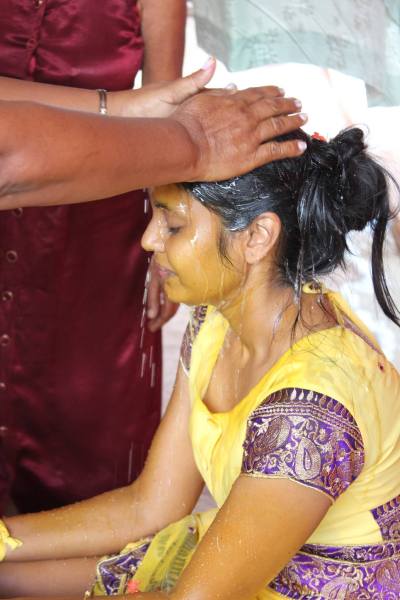
The Nuptial bath on the morning of the wedding
The ladies then go for laawa where a tray of the previously parched laawa, sindoor and coconut oil is taken to one of the villager’s homes accompanied by tassa and dancing. After the ritual all married women apply sindoor and return to the ‘wedding house
Boy side
Naiw Chawar is performed that is, the boy’s nails of both hands and feet are trimmed and painted (usually red) and also decorated with henna. The boy is then dressed. Following this the boy’s mother sits on a chair and the boy on a peerha (small bench). She wears the head wear with the mowire hanging on to the boy’s head.
Emli ghotaaway, another ritual takes place which is performed by the mother’s sister, brother or brother’s wife. Five mango leaves are circled around the son and mother’s head and then the son bites the tips of the mango leaf. After the boy is dressed, his sister applies Kajal for him and the pundit put the chandan (tilak). The brother-in-law puts on his shoes and takes him to the car where five ladies would parchay (ceremony of welcome with lights or water) and throw small loyas of flowers in the four directions. The mother gives the son something sweet to drink and the baraat (wedding procession) leaves for the girl’s father home.
Agwaani
The baraat arrives at the girl’s residence with the sound of music or tassa. The girl’s father dressed in white and carrying a lota filled with water, mango leaves and some silver coins, approaches the boy’s father. He hands it over which is emptied by the pundit and the money given to the groom’s father. The ladies approach the wedding car to parchay the boy while is still in the car.
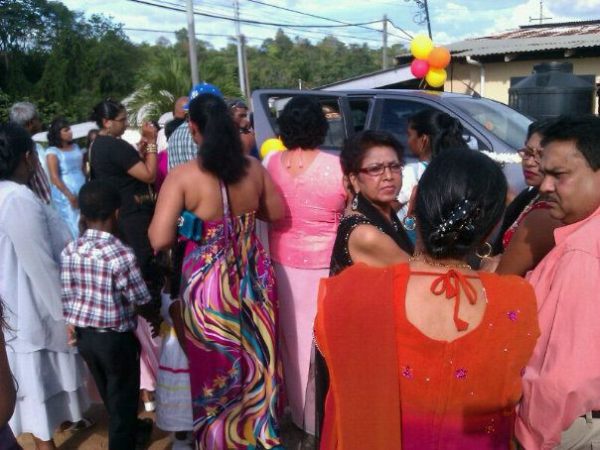
Ladies approaching the wedding vehicle to parchay the groom
Dwaar Puja
The boy is escorted to the place prepared for puja, where he together with the girl’s father perform puja to various gods and goddesses. Then the Var ki Paani(water taken from the boy hair while bathing) and the mowire are sent to the marrow where the girl’s Emmli Ghataaway and Naiw Chaawar takes place.The mowire is place on the girls head and a tilak is placed on the boy’s head. Dakshina is given to the dulaha which includes a tharia with rice, khurma, coconut, a shirt other clothes, money, flowers, sopari and paan. The pundit recites prayers at this handing over ceremony. When this puja is completed the boy’s party is led to the Janwcas (place specially prepared for the bridegroom’s party) where they receive sweet foods and sweet drinks.
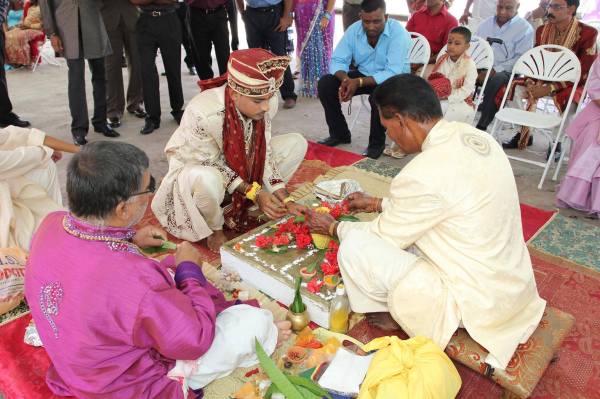
Groom performing puja with the bride’s father
The bride’s Emli Ghotoaway and Nai Chaawar of the bride are completed by now and she performs puja directed by the pundit. The groom’s older brother brings gifts of clothing and jewelry for the bride (daal pujaaway) which is handed to the bride’s mother with a parcel of kharma (meethai – sweets )
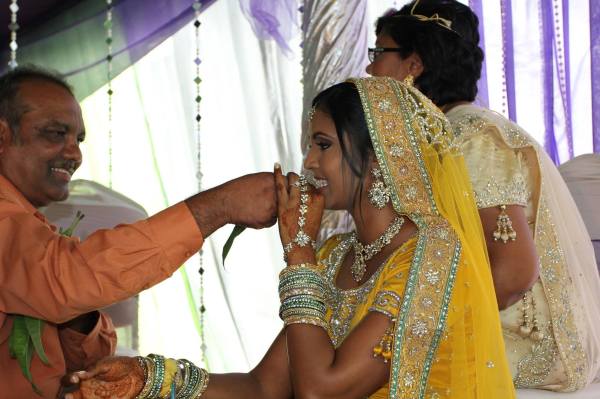
Bride’s Emli ghotaaway
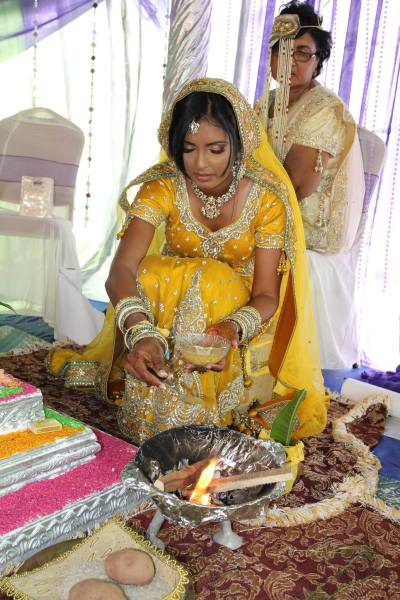
Bride performing puja
The girl now leaves the vaydee and goes inside to get dressed for the other part of the ceremony. If she is in a temple she many wear the same clothes.
Bridegroom Enters
First, there is the ceremony of taking of the shoes. This is followed by the peerha puja which is performed by the groom and the girl’s father. Following this puja a yellow cloth or yellow dhoti is given to the groom which he spreads on the peerha and then sits.
The Bride enters
The bride enters in the presence of the groom for the first time and sits on the eastern side facing west. A paan leaf and flowers are placed on each head and then they face each other and are asked if they agree to the marriage. Once they agree, the paan leaves are exchanged, saffron power is rubbed on both the bride and groom’s palms which is followed by a yellow strip of cloth with doob, rice, saffran and a coin tied into a knot is tied to each of them.
Kanya Daan
The bride is given as a gift to the groom by her father and a ritual is performed by the bride, groom, bride’s mother, bride’s father and the bride’s youngest brother. The groom’s father also takes part.
Paaw Pujay
The girl’s parents wash the feet of the bride and groom and do aarti as well as gives then a gift of money which is handed over to the groom’s father. Others may give money as well. The rings are blessed and exchanged and the marriage is registered according to the law of the land.
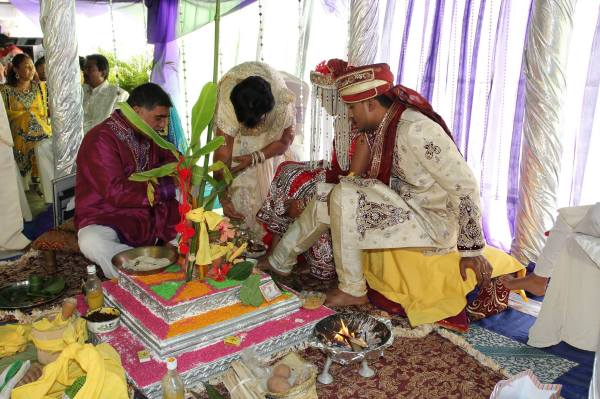
Wedding ceremony
Laawa & Bhaawar
Laawa form both the groom and bride’s side are mixed together and a hawan is done with it. The bride’s youngest brother throws the laawa first on the bamboo fan and then they shake it off onto the vaydee. The bride and groom then takes seven steps around the fire. The bride leads the first four steps, then the groom leads and they both walking side by side on the seventh.
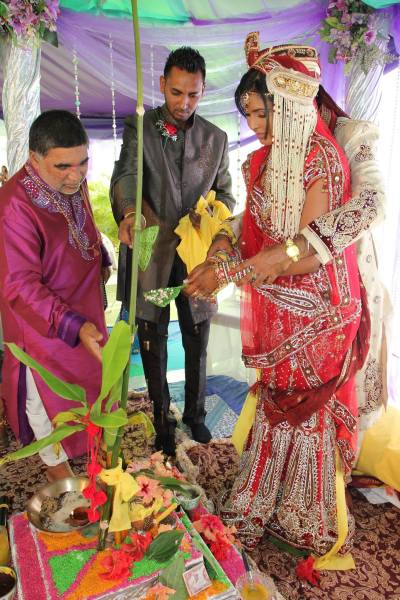
Bride and groom fanning the parched laawa unto the vadi
The first four steps – wife is given charge of the home, children, purse & religious rites
Next two steps- husband is given charge of providing for the earnings for the family welfare & protection of the family
Steeping on the stone (Sheela Aarohan)
The bride’s foot is place on the stone by the groom’s foot and a ritual is performed for strength. When a stone is unavailable and a lorha is used, in which case, the hands and not the feet are place as a kangan is tied on the lorha and thus it should not be touched with the feet.
Surya Darshan, and Dhruv Darshan
Both the bride and groom faces the direction of the sun and northern direction and prays for brightness and guidance in their lives as well as fertility respectively.
Hirdai Sparsh
Both bride and groom faces each other as the vows are read by the pundit.
Sindoor Daan
The bride and groom are covered with a sheet and the groom applies sindoor powder (vermillion) to the middle parting of the bride’s head seven times. Bahoray sindoor – the boy‘s married sister, goes under the sheet and adjusts it if it is not done properly. The parents must not look at the sindoor daan proceedings. Sindoor must be worn at all times once the husband is alive to ensure his long life.
Taag Paat
The groom’s elder brother places a pink wooden garland around the bride’s neck symbolizing that he would assume the duties of the husband and father in their absence. This does not refer to sexual relations in the case of the husband.
The pundit as well as married women and children bless the couple by showering rice and doob grass on the couple. The couple then retreats to the girls’ father’s home where they get dressed and prepare to leave.
Khitcharee
The groom leaves his headdress with the mother-in-law and returns to the marrow. Here he is given money by friends and family of the bride and invited to partake of a meal provided.
Bride and groom leaves for home
They are showered with rice and flowers. The fathers of the couple must shake the marriage tent after the wedding but before the couple leaves.
At the groom’s home, they are welcomed with aarti and the bride must place her right foot first into the house. She is given many presents when she is seated also a beautiful and healthy male child is placed on her lap with the wish that she would have children. They are given sweet fruits to eat. The bride and groom then feed each other sweet rice and dhalpuri with something sweet to drink.
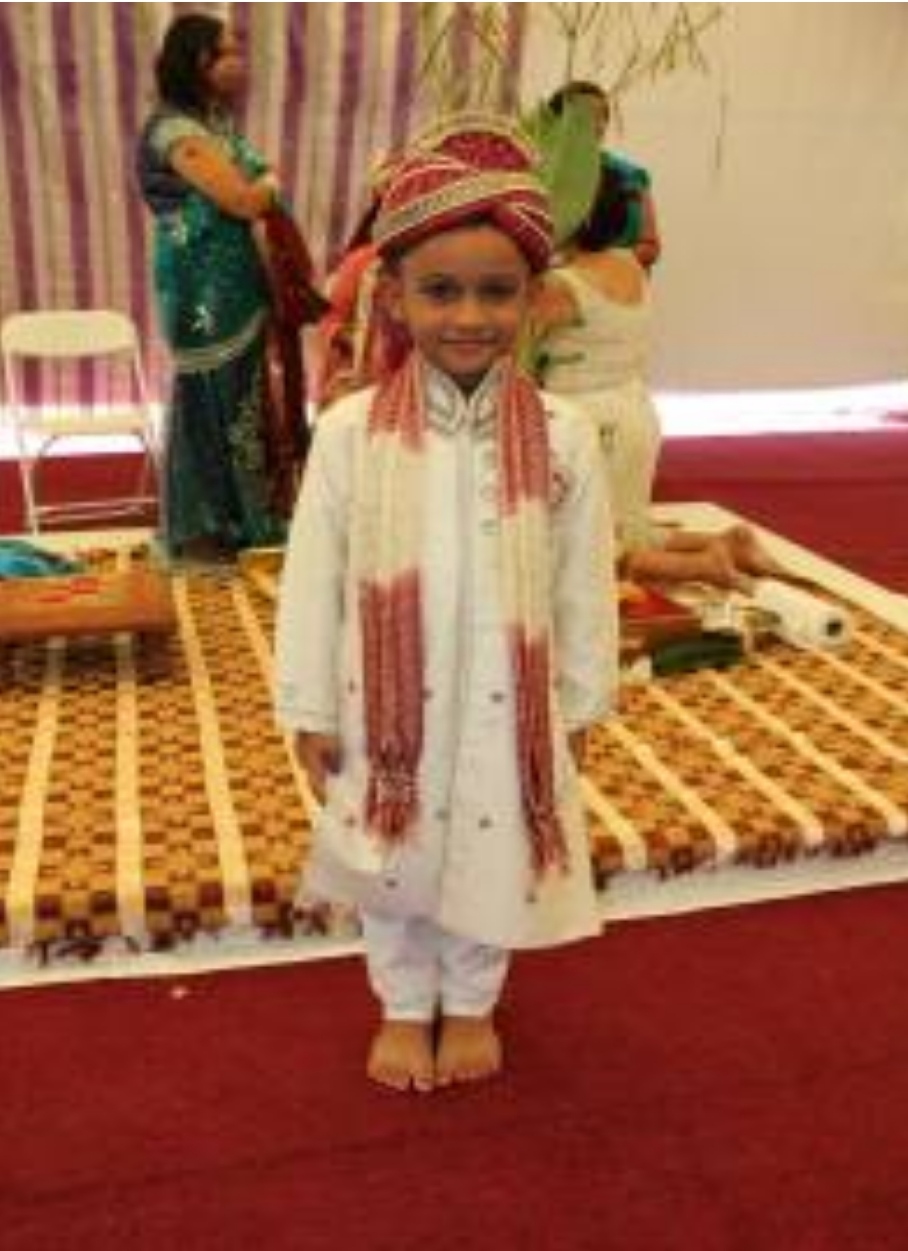
Beautiful and healthy male child that would be placed on the bride’s lap to symbolised the wish that the bride would bare children.
The yellow cloth is taken of the wrists on the 3rd day and thrown into a river.
On the Wednesday after the marriage the bride returns to her father’s house.
The following Sunday, the husband returns for his wife.
Nuptial ceremony
This is the removing of the marriage canopy and the gods being dismissed to their respective places.


